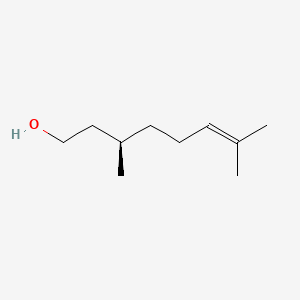| Authors | Title | Published | Journal | PubMed Link |
|---|---|---|---|---|
| Sui HY et al. | Involvement of protein kinase A activation and phospholipase A(2) inhibition in the adenosine-activated basolateral 50 pS K(+) channels in the thick ascending limb of the rat kidney. | 2012 | Sheng Li Xue Bao | pmid:22907306 |
| Kaur S et al. | Citronellol disrupts membrane integrity by inducing free radical generation. | 2011 May-Jun | Z. Naturforsch., C, J. Biosci. | pmid:21812343 |
| Dhake KP et al. | Improved activity and stability of Rhizopus oryzae lipase via immobilization for citronellol ester synthesis in supercritical carbon dioxide. | 2011 | J. Biotechnol. | pmid:21884733 |
| Zore GB et al. | Evaluation of anti-Candida potential of geranium oil constituents against clinical isolates of Candida albicans differentially sensitive to fluconazole: inhibition of growth, dimorphism and sensitization. | 2011 | Mycoses | pmid:20337938 |
| Abbasipour H et al. | Fumigant toxicity and oviposition deterrency of the essential oil from cardamom, Elettaria cardamomum, against three stored–product insects. | 2011 | J. Insect Sci. | pmid:22242564 |
| Sekiguchi F et al. | Delayed production of arachidonic acid contributes to the delay of proteinase-activated receptor-1 (PAR1)-triggered prostaglandin E2 release in rat gastric epithelial RGM1 cells. | 2011 | J. Cell. Biochem. | pmid:21328464 |
| Anwar K et al. | COX-2 inhibition and inhibition of cytosolic phospholipase A2 increase CD36 expression and foam cell formation in THP-1 cells. | 2011 | Lipids | pmid:21181286 |
| Schulte RR et al. | Cytosolic phospholipase A2 as a molecular target for the radiosensitization of ovarian cancer. | 2011 | Cancer Lett. | pmid:21397389 |
| Wang M et al. | Stimulation of A(â‚‚a) adenosine receptor abolishes the inhibitory effect of arachidonic acid on the basolateral 50-pS K channel in the thick ascending limb. | 2011 | Am. J. Physiol. Renal Physiol. | pmid:21209003 |
| Schleheck D et al. | Complete genome sequence of Parvibaculum lavamentivorans type strain (DS-1(T)). | 2011 | Stand Genomic Sci | pmid:22675581 |
beta-Citronellol
Beta-citronellol is a lipid of Prenol Lipids (PR) class. The involved functions are known as Glycolysis.
Cross Reference
Introduction
To understand associated biological information of beta-Citronellol, we collected biological information of abnormalities, associated pathways, cellular/molecular locations, biological functions, related genes/proteins, lipids and common seen animal/experimental models with organized paragraphs from literatures.
What diseases are associated with beta-Citronellol?
There are no associated biomedical information in the current reference collection.
No disease MeSH terms mapped to the current reference collection.
PubChem Associated disorders and diseases
What pathways are associated with beta-Citronellol
There are no associated biomedical information in the current reference collection.
PubChem Biomolecular Interactions and Pathways
Link to PubChem Biomolecular Interactions and PathwaysWhat cellular locations are associated with beta-Citronellol?
There are no associated biomedical information in the current reference collection.
What functions are associated with beta-Citronellol?
Related references are published most in these journals:
| Function | Cross reference | Weighted score | Related literatures |
|---|
What lipids are associated with beta-Citronellol?
There are no associated biomedical information in the current reference collection.
What genes are associated with beta-Citronellol?
There are no associated biomedical information in the current reference collection.
What common seen animal models are associated with beta-Citronellol?
There are no associated biomedical information in the current reference collection.
